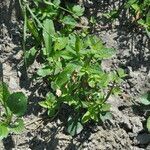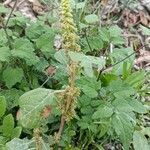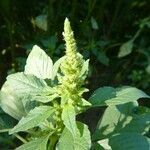Erect, ± hairy annual herb to c. 80 cm high, but plants often only a few cm high in impoverished conditions. Stem angular, ± hairy when young, red, especially towards base. Petiole to c. 7 cm long, often reddish, usually hairy. Lamina extremely variable according to habitat, 2-11 × 1-7 cm (smaller in infl. and very depauperate plants), ovate or rhombic-ovate, usually glabrate beneath and becoming glabrous above; base narrow-cuneate to attenuate; apex obtuse, sometimes mucronate. Panicles green, with elongated main spike to c. 25 cm long at fruiting, with shorter spikes in axils of uppermost lvs, the lvs sometimes very reduced. Longer bracteoles 4-8 mm long, ovate, with long subulate green tip; shorter bracteoles similar. Fls 4-5-merous; tepals very unequal, especially in ♀ fls; ♀ fls with 1-2 longer and 3 shorter tepals, the longer 2.5-3-(4) mm, ± oblong, keeled, gradually tapering to the sharply acute or short-acuminate apex. Fr. subglobose, circumscissile, usually with prominent neck, not exceeding tepals except for the 3 persistent stigmas. Seed 1-1.5 mm diam., lenticular, dark brown or black.
Monoecious, to 2 m, freely branched, puberulent to villous in the infl, otherwise glabrous or puberulent; lvs long-petioled, lance-ovate to deltoid-elliptic, to 10( 15) cm in well developed plants, glabrous or nearly so; infl terminal, stiff, dense and spike-like, unbranched or with a few widely spaced long branches, dull greenish, not showy; bracts ca 5 mm, much surpassing the sep and frs, with a very thick, excurrent midrib; sep 3–5, with simple midvein, those of the pistillate fls sharply acute, nearly straight, unequal, 2–3(–3.5) mm, the longer (outer) ones generally surpassing the fr; stamens as many as the sep; style-branches elongate, recurved from the thickened base; fr slightly rugose, circumscissile; seed dark brown, suborbicular, 1–1.3 mm; 2n=34. Native to open habitats in w. N. and S. Amer., now a common weed in w. U.S., and becoming established in our range.
An annual plant. It is erect and grows to 1.8 m high. The flowers are green.




